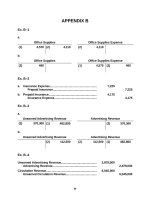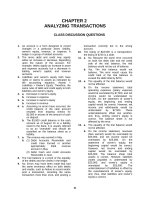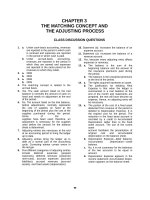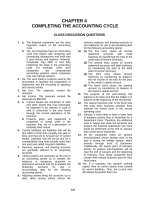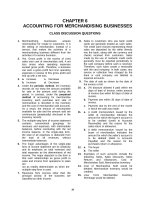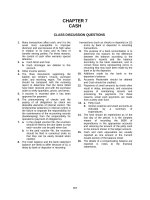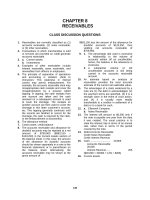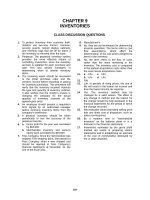Solution manual accounting 21e by warreni ch 13
Bạn đang xem bản rút gọn của tài liệu. Xem và tải ngay bản đầy đủ của tài liệu tại đây (173.19 KB, 50 trang )
CHAPTER 13
Accounting for Partnerships and
Limited Liability Corporations
CLASS DISCUSSION QUESTIONS
1. Proprietorship: Ease of formation.
Corporation: Limited liability to owners and
ease of raising large amounts of equity
capital.
Partnership: Expanded owner expertise and
capital and ease of formation.
Limited liability corporation: Limited liability to
owners.
2. The disadvantages of a partnership are its
life is limited, each partner has unlimited
liability, one partner can bind the partnership
to contracts, and raising large amounts of
capital is more difficult for a partnership than
a corporation.
3. Yes. A partnership may incur losses in
excess of the total investment of all partners.
The division of losses among the partners
would be made according to their
agreement. In addition, because of the
unlimited liability of each partner for
partnership debts, a particular partner may
actually lose a greater amount than his or
her capital balance.
4. The partnership agreement (partnership) or
operating agreement (LLC) establishes the
income-sharing ratio among the partners
(members), amounts to be invested, and
buy-sell agreements between the partners
(members).
5. Equally.
6. No. He would have to bear his share of
losses. In the absence of any agreement as
to division of net income or net loss, his
share would be one-third. In addition,
because of the unlimited liability of each
partner, DiPano may lose more than onethird of the losses if one partner is unable to
absorb his share of the losses.
7. The statement of stockholders’ equity
discloses the material changes in each
stockholders’ equity account, such as
common stock, paid-in excess of par value,
retained earnings, and treasury stock, for a
specified period.
8. The statement of partners’ equity (for a
partnership) and statement of members’
equity (for a LLC) both show the material
changes in owner’s equity for each
ownership person or class for a specified
period.
9. The delivery equipment should be recorded
at $15,000, the valuation agreed upon by the
partners.
10. The accounts receivable should be recorded
by a debit of $200,000 to Accounts
Receivable and a credit of $20,000 to
Allowance for Doubtful Accounts.
11. Yes. Partnership net income is divided
according to the income-sharing ratio,
regardless of the amount of the withdrawals
by the partners. Therefore, it is very likely
that the partners’ monthly withdrawals from a
partnership will not exactly equal their shares
of net income.
12. a. Debit the partner’s drawing account and
credit Cash.
b. Debit the income summary account for
the amount of the net income and credit
the partners’ capital accounts for their
respective shares of the net income.
c. No. Payments to partners and the
division of net income are separate. The
amount of one does not affect the
amount of the other.
13. a. By purchase of an interest, the capital
interest of the new partner is obtained
from the old partner, and neither the total
assets nor the total equity of the
partnership are affected.
b. By investment, both the total assets and
the total equity of the partnership are increased.
14. It is important to state all partnership assets
in terms of current prices at the time of the
admission of a new partner because failure
to do so might result in participation by the
new partner in gains or losses attributable to
the period prior to admission to the
partnership. To illustrate, assume that A and
B share net income and net loss equally and
operate a partnership that owns land
recorded at and costing $20,000. C is
83
15.
16.
admitted to the partnership, and the three
partners share in income equally. The day
after C is admitted to the partnership, the
land is sold for $35,000 and, since the land
was not revalued, C receives one-third
distribution of the $15,000 gain. In this case,
C participates in the gain attributable to the
period prior to admission to the partnership.
A new partner who is expected to improve
the fortunes (income) of the partnership
might be given equity in excess of the
amount invested to join the partnership.
a. Losses and gains on realization are
divided among partners in the incomesharing ratio.
b. Cash is distributed to the partners
according to their ownership claims, as
indicated by the credit balances in their
capital accounts, after taking into
consideration the potential deficiencies
that may result from the inability to
collect from a deficient partner.
17.
84
The
different
advantages
of
each
organizational form are related to the natural
life cycle of a business. For example, during
the initial stages of a business, ease of
formation may be paramount, which favors a
proprietorship. As a business grows and
succeeds, the need for expertise and capital
grows, giving rise to partnerships. If limited
liability becomes paramount to outside
investors, such as venture capitalists, then
the business may take the form of a limited
liability corporation. Lastly, a business may
wish to obtain more extensive sources of
capital, such as from the investing public. In
this case, the corporate form is best suited
for raising public capital with the help of an
underwriter through an initial public offering.
EXERCISES
Ex. 13–1
TENDER HEART GREETING CARDS INC
Statement of Stockholders’ Equity
For the Year Ended December 31, 2006
Paid-In
Common Capital in
Stock,
Excess Treasury Retained
$2 Par
of Par
Stock
Earnings
Balance, Jan. 1, 2006....
Issued 50,000 shares
of common stock.....
Purchased 10,000
shares as treasury
stock.........................
Net income....................
Dividends......................
Balance, Dec. 31, 2006..
$500,000
$400,000
100,000
45,000
—
$1,975,000
145,000
$(25,000)
$600,000
$1,075,000
Total
$445,000 $(25,000)
(25,000)
240,000
240,000
(50,000)
(50,000)
$1,265,000 $2,285,000
Ex. 13–2
Cash........................................................................................
Accounts Receivable..............................................................
Merchandise Inventory............................................................
Equipment...............................................................................
Allowance for Doubtful Accounts.......................................
Todd Jost, Capital..............................................................
6,000
91,000
76,500
90,000
8,000
255,500
Ex. 13–3
a.
b.
c.
d.
e.
........................................................................................
........................................................................................
........................................................................................
........................................................................................
........................................................................................
Moore
Knell
$60,000
80,000
57,600
55,000
61,000
$60,000
40,000
62,400
65,000
59,000
Details
Moore
Knell
Total
a. Net income (1:1)..........................................
$60,000
$60,000
$120,000
b. Net income (2:1)..........................................
$80,000
$40,000
$120,000
c. Interest allowance.......................................
Remaining income (2:3)..............................
Net income...................................................
$24,000
33,600
$57,600
$12,000
50,400
$62,400
$ 36,000
84,000
$120,000
d. Salary allowance.........................................
Remaining income (1:1)..............................
Net income...................................................
$40,000
15,000
$55,000
$50,000
15,000
$65,000
$ 90,000
30,000
$120,000
e. Interest allowance.......................................
Salary allowance.........................................
Excess of allowances over income (1:1)...
Net income...................................................
$24,000
40,000
(3,000)
$61,000
$12,000
50,000
(3,000)
$59,000
$ 36,000
90,000
(6,000)
$120,000
Ex. 13–4
Moore
a.
b.
c.
d.
e.
........................................................................................
........................................................................................
........................................................................................
........................................................................................
........................................................................................
$ 90,000
120,000
81,600
85,000
91,000
Knell
$90,000
60,000
98,400
95,000
89,000
Details
Moore
Knell
Total
a. Net income (1:1)...............................................
$ 90,000
$90,000
$180,000
b. Net income (2:1)...............................................
$120,000
$60,000
$180,000
c. Interest allowance............................................
Remaining income (2:3)...................................
Net income........................................................
$ 24,000
57,600
$ 81,600
$12,000
86,400
$98,400
$ 36,000
144,000
$180,000
d. Salary allowance..............................................
Remaining income (1:1)...................................
Net income........................................................
$ 40,000
45,000
$ 85,000
$50,000
45,000
$95,000
$ 90,000
90,000
$180,000
e. Interest allowance............................................
Salary allowance..............................................
Remaining income (1:1)...................................
Net income........................................................
$ 24,000
40,000
27,000
$ 91,000
$12,000
50,000
27,000
$89,000
$ 36,000
90,000
54,000
$180,000
Ex. 13–5
Salary allowances..........................................
Remainder ($120,000)(net loss, $20,000
plus $100,000 salary allowances)
divided equally..........................................
Net loss...........................................................
Jane
Williams
Osaka
Y.
Total
$ 40,000
$ 60,000
(60,000)
$ (20,000)
$
(60,000)
0
$ 100,000
(120,000)
$ (20,000)
Ex. 13–6
The partners can divide net income in any ratio that they wish. However, in the
absence of an agreement, net income is divided equally between the partners.
Therefore, Jim’s conclusion was correct, but for the wrong reasons. In addition,
note that the salary allowances have no impact on the division of income.
Ex 13–7
a.
Net income: $106,000
Salary allowance............................................
Remaining income.........................................
Net income.....................................................
Bennings
Hodges
Total
$32,000
12,600
$44,600
$53,000
8,400
$61,400
$ 85,000
21,000
$106,000
Bennings remaining income: ($106,000 – $85,000) × (3/5)
Hodges remaining income: ($106,000 – $85,000) × (2/5)
b.
(1)
Income Summary................................................................
L. Bennings, Member Equity.........................................
L. Hodges, Member Equity............................................
106,000
44,600
61,400
(2)
L. Bennings, Member Equity..............................................
L. Hodges, Member Equity.................................................
L. Bennings, Drawing....................................................
L. Hodges, Drawing.......................................................
32,000
53,000
32,000
53,000
Note: The reduction in members’ equity from withdrawals would be disclosed on
the statement of members’ equity but does not affect the allocation of net income
in part (a) of this exercise.
Ex 13–8
a.
Salary allowance.......................
Interest allowance (8%)............
Total allowances.......................
Remaining income (4:3:3)........
Net income................................
WXXY Radio
Partners
John
Higgins
Daily Call
Newspaper,
LLC
Total
$ 12,800
$ 12,800
217,840
$230,640
$125,000
7,600
$132,600
163,380
$295,980
$ 20,000
$ 20,000
163,380
$183,380
$125,000
40,400
$165,400
544,600
$710,000
b.
Dec. 31, 2006
Dec. 31, 2006
Income Summary..........................................
WXXY Radio Partners, Member Equity. .
John Higgins, Member Equity................
Daily Call Newspaper, LLC, Member
Equity..................................................
710,000
WXXY Radio Partners, Member Equity.......
John Higgins, Member Equity.....................
Daily Call Newspaper, LLC, Member Equity
WXXY Radio Partners, Drawing.............
John Higgins, Drawing...........................
Daily Call Newspaper, LLC, Drawing.....
12,800
132,600
230,640
295,980
183,380
20,000
12,800
132,600
20,000
c.
MEDIA PROPERTIES, LLC
Statement of Members’ Equity
For the Year Ended December 31, 2006
WXXY
Radio
Partners
Members' equity, January 1, 2006.......... $160,000
Additonal investment during the year. . .
50,000
$210,000
Net income for the year.......................... 230,640
$440,640
Withdrawals during the year..................
12,800
Members' equity, December 31, 2006... . $427,840
Daily Call
John Newspaper,
Higgins
LLC
Total
$ 95,000 $250,000 $ 505,000
50,000
$ 95,000 $250,000 $ 555,000
295,980 183,380
710,000
$390,980 $433,380 $1,265,000
132,600
20,000
165,400
$258,380 $413,380 $1,099,600
Ex. 13–9
a.
(1)
(2)
Income Summary.............................................................
Walt Bigney, Capital....................................................
Dan Harris, Capital.....................................................
160,000
Walt Bigney, Capital.........................................................
Dan Harris, Capital...........................................................
Walt Bigney, Drawing..................................................
Dan Harris, Drawing...................................................
72,000
84,000
80,000
80,000
72,000
84,000
b.
BIGNEY AND HARRIS
Statement of Partners’ Equity
For the Year Ended December 31, 2006
Capital, January 1, 2006................................
Additional investment during the year.........
Net income for the year.................................
Withdrawals during the year.........................
Capital, December 31, 2006...........................
Walt
Bigney
Dan
Harris
Total
$ 80,000
10,000
$ 90,000
80,000
$170,000
72,000
$ 98,000
$ 95,000
—
$ 95,000
80,000
$175,000
84,000
$ 91,000
$175,000
10,000
$185,000
160,000
$345,000
156,000
$189,000
Ex 13–10
a.
Jan. 31
Partner Drawing..................................
Cash................................................
20,000,000
Income Summary................................
Partner Capital...............................
200,000,000
Partner Capital.....................................
Partner Drawing.............................
240,000,000*
20,000,000
b.
Dec. 31
200,000,000
c.
Dec. 31
240,000,000
*12 months × 20,000,000
d.
Dec. 31
Cash.....................................................
Partner Capital...............................
40,000,000
40,000,000
During the year, the partners withdrew 40 million pounds more than what was
earned. This represents a distribution of capital beyond the current year’s
earnings. According to the operating agreement, this difference must be returned
to the partnership.
Ex. 13–11
a. and b.
Kirk, Capital...................................................................
McCoy, Capital..........................................................
30,000
30,000
Ex. 13–12
a. $811,000 ($1,840,000,000 ÷ 2,270), rounded
b. $132,000 ($300,000,000 ÷ 2,270), rounded
c. A new partner might contribute more than $132,000 because of goodwill
attributable to the firm’s reputation, future income potential, a strong client
base, etc.
Ex. 13–13
a.
b.
(1) Susan Yu, Capital....................................................
Ben Hardy, Capital..................................................
Ken Mahl.............................................................
25,000
18,000
(2) Cash.........................................................................
Jeff Wood, Capital..............................................
35,000
Susan Yu.......................................................................
Ben Hardy.....................................................................
Ken Mahl.......................................................................
Jeff Wood......................................................................
75,000
72,000
43,000
35,000
43,000
35,000
Ex. 13–14
a.
b.
Cash..............................................................................
Cecil Jacobs, Capital....................................................
Maria Estaban, Capital.................................................
Lee White, Capital....................................................
45,000
5,000
5,000
Cecil Jacobs.................................................................
Maria Estaban...............................................................
Lee White......................................................................
56,000
54,000
55,000
55,000
Ex. 13–15
a. Conway, Member Equity.................................................
Patel, Member Equity......................................................
Medical Equipment....................................................
1
2
5,6001
8,4002
14,000
$14,000 × 2/5 = $5,600
$14,000 × 3/5 = $8,400
b. 1. Cash............................................................................
Conway, Member Equity......................................
Patel, Member Equity...........................................
Truet, Member Equity...........................................
340,000
20,080
30,120
289,800
Supporting calculations for the bonus:
Equity of Conway.......................................
Equity of Patel............................................
Contribution by Truett...............................
Total equity after admitting Truett.............
Truett’s equity interest after admission....
Truett’s equity after admission.................
$294,400
331,600
340,000
$966,000
30%
$289,800
Contribution by Truett...............................
Truett’s equity after admission.................
Bonus paid to Conway and Patel..............
$340,000
289,800
$ 50,200
Conway: $50,200 × 2/5 = $20,080
Patel: $50,200 × 3/5 = $30,120
b. 2. Cash............................................................................
Conway, Member Equity............................................
Patel, Member Equity.................................................
Truet, Member Equity...........................................
Supporting calculations for the bonus:
Equity of Conway.......................................
Equity of Patel............................................
Contribution by Truett...............................
Total equity after admitting Truett.............
Truett’s equity interest after admission....
Truett’s equity after admission.................
Contribution by Truett...............................
Bonus paid to Truett..................................
Conway: $22,160 × 2/5 = $8,864
Patel: $22,160 × 3/5 = $13,296
$294,400
331,600
190,000
$816,000
26%
$212,160
190,000
$ 22,160
190,000
8,864
13,296
212,160
Ex 13–16
ANGEL INVESTOR ASSOCIATES
Statement of Partnership Equity
For the Year Ended December 31, 2006
Jan
Strous,
Capital
Cara
Wright,
Capital
Michael
Black,
Capital
Total
Partnership
Capital
Partnership Capital, January 1, 2006........ $ 31,500 $ 58,500 $
$ 90,000
Revaluation of assets................................
(3,500)
(6,500)
(10,000)
Admission of Michael Black......................
2,800
5,200
22,000
30,000
Salary allowance........................................ 12,000
12,000
Remaining income..................................... 44,800
83,200
32,000 160,000
Less: Partner withdrawals......................... (28,400) (41,600) (16,000) (86,000)
Partnership Capital, December 31, 2006. . $ 59,200 $ 98,800 $ 38,000 $196,000
Supporting Calculations
Income-sharing ratio prior to admitting Black:
Jan Strous:
Cara Wright:
$31,500
= 35%
$90,000
$58,500
= 65%
$90,000
Revaluation of assets:
Jan Strous: $10,000 × 35% = $3,500 reduction in capital account
Cara Wright: $10,000 × 65% = $6,500 reduction in capital account
Ex. 13–16
Concluded
Admission of Michael Black:
Equity of initial partners prior to admission.................
Contribution by Black.....................................................
Total.................................................................................
Black's equity interest after admission.........................
Black's equity after admission.......................................
$ 80,000
30,000
$110,000
20%
$ 22,000
Contribution by Black.....................................................
Black's equity after admission.......................................
Bonus paid to Strous and Wright..................................
$ 30,000
22,000
$ 8,000
The bonus is distributed to Strous and Wright according to their income-sharing
ratio prior to admitting Black:
Strous: $8,000 × 35% = $2,800
Wright: $8,000 × 65% = $5,200
Net income distribution:
The revised income-sharing ratio is equal to the proportion of the capital
balances after admitting Black according to the partnership agreement:
Jan Strous:
$30,800
= 28%
$110 ,000
Cara Wright:
$57,200
= 52%
$110 ,000
Michael Black:
$22,000
= 20%
$110 ,000
Alternatively, the original income-sharing ratios for Strous and Wright could be
multiplied by 80% (100% less the 20% sold to Black) to obtain 28% and 52%,
respectively. Leaving 20% for Black.
These ratios can be multiplied by the $160,000 remaining income ($172,000 –
$12,000 salary allowance to Strous) to distribute the earnings to the respective
partner capital accounts.
Withdrawals:
Half of the income distribution for Wright and Black and half of the income
distribution plus salary allowance for Strous. Strous need not take the salary
allowance as a withdrawal but may allow it to accumulate in the member equity
account.
Ex. 13–17
a.
b.
Merchandise Inventory................................................
Allowance for Doubtful Accounts..........................
Glenn Otis, Capital..................................................
Tammie Sawyer, Capital..........................................
Joe Parrott, Capital.................................................
15,000
Glenn Otis, Capital.......................................................
Cash.........................................................................
Notes Payable.........................................................
205,100
3,100
5,100
3,400
3,400
55,100
150,000
Ex. 13–18
a.
The income-sharing ratio is determined by dividing the net income for each
member by the total net income. Thus, in 2005 the income-sharing ratio is as
follows:
Golden Properties, LLC:
Aztec Holdings, Ltd.:
$50,000
= 40%
$125,000
$75,000
= 60%
$125,000
Or a 2:3 ratio
b. Following the same procedure as in (a):
Golden Properties, LLC:
Aztec Holdings, Ltd.:
Jason Fields:
$106,880
= 32%
$334,000
$160,320
= 48%
$334,000
$66,800
= 20%
$334,000
Ex. 13–18
Concluded
c. The member withdrawal ratios do not match the income-sharing ratio, shown
as follows:
$32,000
Golden Properties, LLC:
= 24.6%
$130,000
Aztec Holdings, Ltd.:
Jason Fields:
$48,000
= 36.9%
$130,000
$50,000
= 38.5%
$130,000
Clearly, the distribution to Jason Fields is disproportionably higher while the
distributions to Golden Properties and Aztec Holdings are lower than their
respective income-sharing ratios. Distributions need not be in the same
proportion as the income-sharing ratio. Members may make withdrawals from
the business as long as their member equity remains positive and the
operating agreement allows such withdrawals.
d. Jason Fields provided a $183,750 cash contribution to the business. The
amount credited to his member equity account is this amount plus his bonus
($20,000), or $203,750.
e. The negative entries to Golden Properties and Aztec Holdings are the result of
a bonus paid to Jason Fields.
f.
Jason Fields acquired a 20% interest in the business, computed as follows:
Jason Fields’ member equity after admission. .
Golden Properties, LLC, member equity...........
Aztec Holdings, Ltd. member equity..................
Total.....................................................................
$ 203,750
332,000
483,000
$1,018,750
Fields’ ownership interest after admission
($203,750 ÷ $1,018,750).......................................
20.00%
Ex. 13–19
a.
Cash balance..................................................
Sum of capital accounts................................
Loss from sale of noncash assets................
$ 20,000
25,000
$ 5,000
b. and c.
Capital balances before realization..............
Division of loss on sale of noncash assets
Balances.........................................................
Cash distributed to partners.........................
Final balances................................................
Hires
Bellman
$ 5,000
2,500
$ 2,500
2,500
$
0
$ 20,000
2,500
$ 17,500
17,500
$
0
Ex. 13–20
Goldburg
Luce
Capital balances before realization.....................
Division of loss on sale of noncash assets
($97,000 – $67,000)...........................................
Capital balances after realization........................
Cash distributed to partners................................
Final balances.......................................................
$ 57,000
$ 40,000
15,000
$ 42,000
42,000
$
0
15,000
$ 25,000
25,000
$
0
Ex. 13–21
a.
Deficiency
b.
$60,000 ($20,000 + $57,500 – $17,500)
c.
Cash...............................................................................
Nell, Capital...............................................................
Capital balances after realization.......
Receipt of partner deficiency.............
Capital balances after eliminating
deficiency.......................................
17,500
17,500
Bakki
Towers
Nell
$ 20,000
$ 57,500
$(17,500) Dr.
17,500
$ 20,000
$ 57,500
$
0
Ex. 13–22
a.
Cash should be distributed as indicated in the following tabulation:
Capital invested................................
Net income........................................
Capital balances and cash
distribution....................................
b.
Meyer
Ball
David
Total
$ 175
+ 100
$ 125
+ 100
$ —
+ 100
$ 300
+ 300
$ 275
$ 225
$ 100
$ 600
David has a capital deficiency of $60, as indicated in the following tabulation:
Capital invested................................
Net loss.............................................
Capital balances...............................
Meyer
Ball
David
$ 175
– 60
$ 115
$ 125
– 60
$ 65
Total
$ —
– 60
$ 60 Dr.
$ 300
– 180
$ 120
Ex. 13–23
Capital balances after realization.............
Distribution of partner deficiency.............
Capital balances after deficiency
distribution..........................................
Duncan
Tribe
Ho
$(15,000)
15,000
$ 50,000
(10,000)
$ 40,000
(5,000)
$
$ 40,000
$ 35,000
0
Ex. 13–24
GIBBS, HILL, AND MANSON
Statement of Partnership Liquidation
For the Period Ending July 1–29, 20—
Capital
Cash
Balances before realization.............
Sale of assets and division
of loss............................................
Balances after realization................
Payment of liabilities........................
Balances after payment of
liabilities........................................
Distribution of cash to partners......
Final balances...................................
Noncash
+ Assets = Liabilities +
Gibbs
(3/6)
+
Hill
(2/6)
+
Manson
(1/6)
$ 11,000
$ 85,000
$ 30,000
$ 24,000
$ 28,000
$ 14,000
+ 61,000
$ 72,000
– 30,000
– 85,000
$
0
—
—
$ 30,000
– 30,000
– 12,000
$ 12,000
—
– 8,000
$ 20,000
—
– 4,000
$ 10,000
—
$ 42,000
– 42,000
$
0
$
$
$ 12,000
– 12,000
$
0
$ 20,000
– 20,000
$
0
$ 10,000
– 10,000
$
0
0
—
$
0
—
0
$
0
Ex. 13–25
a.
CITY SIGNS, LLC
Statement of LLC Liquidation
For the Period March 1–31, 2006
Member Equity
Cash
Balances before realization.............
Sale of assets and division
of loss............................................
Balances after realization................
Payment of liabilities........................
Balances after payment of
liabilities........................................
Distribution of cash to members.....
Final balances...................................
$
Noncash
+ Assets = Liabilities +
Ellis
(2/5)
+
Roane
(2/5)
+
Clausen
(1/5)
4,000
$125,000
$ 44,000
$ 28,000
$ 45,000
$ 12,000
+ 96,000
$100,000
– 44,000
–125,000
$
0
—
—
$ 44,000
– 44,000
– 11,600
$ 16,400
—
– 11,600
$ 33,400
—
–
$
5,800
6,200
—
$ 56,000
– 56,000
$
0
$
0
$
0
$
$ 16,400
– 16,400
$
0
$ 33,400
– 33,400
$
0
$
–
$
6,200
6,200
0
—
$
0
—
0
b.
Ellis, Member Equity......................................................
Roane, Member Equity..................................................
Clausen, Member Equity...............................................
Cash..........................................................................
16,400
33,400
6,200
56,000
PROBLEMS
Prob. 13–1A
1.
Nov.
1 Cash......................................................................
Merchandise Inventory........................................
E. Tsao, Capital................................................
15,000
55,000
1 Cash......................................................................
Accounts Receivable...........................................
Merchandise Inventory........................................
Equipment.............................................................
Allowance for Doubtful Accounts..................
Accounts Payable...........................................
Notes Payable.................................................
Mark Ivens, Capital..........................................
6,100
31,500
42,900
25,000
70,000
800
9,700
10,000
85,000
2.
TSAO AND IVENS
Balance Sheet
November 1, 2005
Assets
Current assets:
Cash..........................................................
Accounts receivable.................................
Less allowance for doubtful accounts....
Merchandise inventory.............................
Total current assets............................
Plant assets:
Equipment.................................................
Total assets....................................................
$ 21,100
$ 31,500
800
Liabilities
Current liabilities:
Accounts payable.....................................
Notes payable...........................................
Total liabilities................................................
Partners’ Equity
E. Tsao, capital...............................................
Mark Ivens, capital.........................................
Total partners’ equity.....................................
Total liabilities and partners’ equity..............
30,700
97,900
$149,700
25,000
$174,700
$ 9,700
10,000
$ 19,700
$ 70,000
85,000
155,000
$174,700
Prob. 13–1A
Concluded
3.
Oct. 31 Income Summary..................................................
E. Tsao, Capital................................................
Mark Ivens, Capital..........................................
75,500
31 E. Tsao, Capital.....................................................
Mark Ivens, Capital...............................................
E. Tsao, Drawing.............................................
Mark Ivens, Drawing.......................................
26,000
17,500
40,000*
35,500*
26,000
17,500
*Computations:
Interest allowance..........................................
Salary allowance............................................
Remaining income (1:1)................................
Net income.....................................................
Tsao
Ivens
Total
$ 7,000
24,000
9,000
$ 40,000
$ 8,500
18,000
9,000
$ 35,500
$ 15,500
42,000
18,000
$ 75,500
Prob. 13–2A
Plan
(1)
$150,000
Haddox
French
(2)
$90,000
Haddox
French
a.
b.
c.
d.
e.
f.
$ 75,000
60,000
100,000
84,000
87,000
93,000
$45,000
36,000
60,000
48,000
57,000
57,000
...................................................
...................................................
...................................................
...................................................
...................................................
...................................................
$75,000
90,000
50,000
66,000
63,000
57,000
$45,000
54,000
30,000
42,000
33,000
33,000
Details
$150,000
Haddox
$90,000
French
Haddox
French
a.
Net income (1:1)......................... $ 75,000
$ 75,000
$ 45,000
$ 45,000
b.
Net income (2:3)......................... $ 60,000
$ 90,000
$ 36,000
$ 54,000
c.
Net income (2:1)......................... $ 100,000
$ 50,000
$ 60,000
$ 30,000
d.
Interest allowance..................... $ 12,000
Remaining allowance (3:2)........
72,000
Net income................................. $ 84,000
$ 18,000
48,000
$ 66,000
$ 12,000
36,000
$ 48,000
$ 18,000
24,000
$ 42,000
e.
Interest allowance..................... $ 12,000
Salary allowance........................
60,000
Excess of allowances over
income (1:1)............................
Remaining income (1:1)............
15,000
Net income................................. $ 87,000
$ 18,000
30,000
$ 12,000
60,000
$ 18,000
30,000
15,000
$ 63,000
$ 57,000
$ 33,000
Interest allowance..................... $ 12,000
Salary allowance........................
60,000
Bonus allowance.......................
12,000
Excess of allowances over
income (1:1)............................
Remaining income (1:1)............
9,000
Net income................................. $ 93,000
$ 18,000
30,000
$ 12,000
60,000
$ 18,000
30,000
f.
(15,000)
(15,000)
9,000
$ 57,000
$ 57,000
(15,000)
(15,000)
$ 33,000
Prob. 13–3A
1.
REEVES AND STRANGE
Income Statement
For the Year Ended December 31, 2006
Professional fees................................................................
Operating expenses:
Salary expense..............................................................
Depreciation expense—building..................................
Property tax expense....................................................
Heating and lighting expense.......................................
Supplies expense..........................................................
Depreciation expense—office equipment....................
Miscellaneous expense.................................................
Total operating expenses.........................................
Net income..........................................................................
Dan
Reeves
Division of net income:
Salary allowance........................................
Interest allowance......................................
Remaining income.....................................
Net income.......................................................
*$75,000 × 12%
**($55,000 – $5,000) × 12%
$ 25,000
9,000*
55,000
$ 89,000
$316,750
$ 84,500
10,500
10,000
9,900
5,750
5,000
6,100
131,750
$185,000
Ron
Strange
Total
$ 35,000
$ 60,000
6,000**
15,000
55,000
110,000
$ 96,000
$ 185,000
2.
REEVES AND STRANGE
Statement of Partners’ Equity
For the Year Ended December 31, 2006
Capital, January 1, 2006..................................
Additional investment during the year..........
Net income for the year..................................
Withdrawals during the year..........................
Capital, December 31, 2006............................
Dan
Reeves
Ron
Strange
$ 75,000
—
$ 75,000
89,000
$ 164,000
50,000
$ 114,000
$ 50,000
5,000
$ 55,000
96,000
$ 151,000
60,000
$ 91,000
Total
$ 125,000
5,000
$ 130,000
185,000
$ 315,000
110,000
$ 205,000
Prob. 13–3A
Concluded
3.
REEVES AND STRANGE
Balance Sheet
December 31, 2006
Assets
Current assets:
Cash............................................................
Accounts receivable..................................
Supplies......................................................
Total current assets..............................
Plant assets:
Land............................................................
Building......................................................
$ 150,000
Less accumulated depreciation..........
77,500
Office equipment........................................
Less accumulated depreciation..........
Total plant assets............................
Total assets.....................................................
$ 24,500
40,500
2,400
$ 67,400
$ 50,000
72,500
$ 40,000
22,400
Liabilities
Current liabilities:
Accounts payable......................................
Salaries payable.........................................
Total liabilities.................................................
17,600
140,100
$ 207,500
$
1,000
1,500
$
2,500
Partners’ Equity
Dan Reeves, capital........................................
Ron Strange, capital.......................................
Total partners’ equity......................................
Total liabilities and partners’ equity...............
$ 114,000
91,000
205,000
$ 207,500
